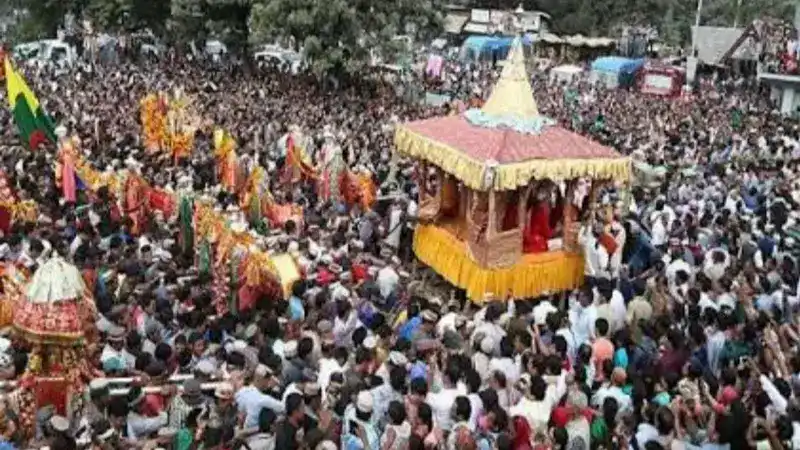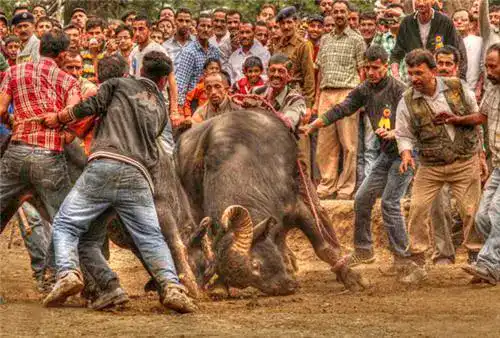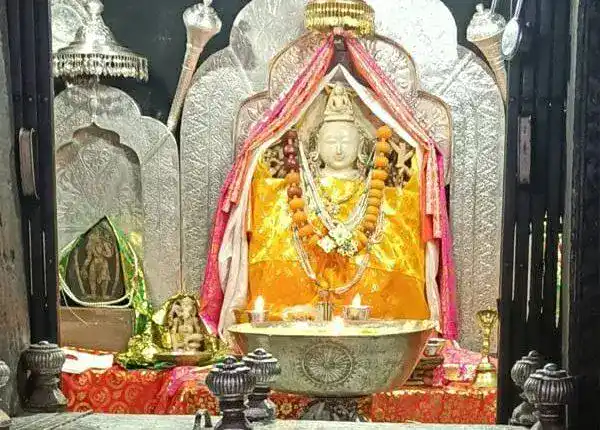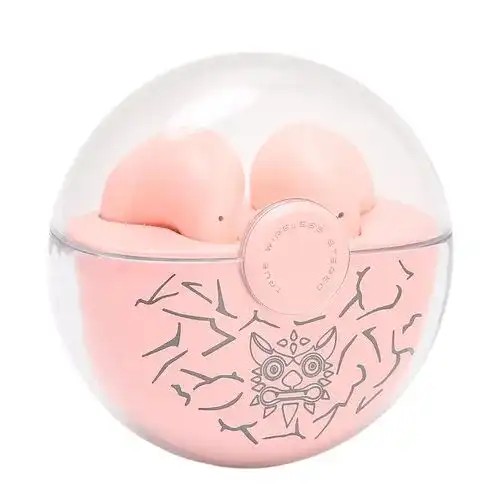Himachal Pradesh has a rich cultural heritage. Besides being breathtakingly beautiful, the people here are warm and welcoming. Festivals are celebrated with zeal and enthusiasm, and everyone takes part actively. Here are 7 of the best festivals celebrated here.
07-Himachal Pradesh: A Cultural Festivals Celebration
1) Kullu Dussehra

Bull fights during Sair festival. Photo Credit: shimlaonline.in
Kullu is known as the valley of Gods. Celebrations here last for a week. The festival is celebrated nine days after Navratri. The procession of Lord Raghunath and other deities, is carried across town in a chariot. Dhalpurmaidan is the center of the festivities. On the last day of the festival sacrifices are made, and a huge bonfire is lit. The idol of Lord Raghunath is placed back at its original place via a procession. It is taken to the banks of the river Beas. A portion of wood grass is burnt, signifying the burning of Lanka. In earlier days, regional arts and crafts were exchanged during the festival. It promoted local artisans. However, it is now a commercial event, and traditional items have been replaced by goods from around the world.
When– October
Where– Kullu
Experience– There is enjoyment in the air with stalls, fairs, dancing, feasting, and drinking through the week-long celebrations.
2) Sair festival

Bull fights during Sair festival. Photo Credit: shimlaonline.in
Sair festival marks the end of the crop harvest and the start of the harsh winter. The harvest crops are offered to the Gods. Young family members present “Dhruv” which is a sacred grass and dry fruit item, to the elder members of the family. People start preparing to store the grains and firewood required for winter. Delicious meals are prepared and distributed among relatives and friends. Villagers beat drums and blow trumpets to welcome the various deities to their respective temples. You can practice drumming by purchasing them here https://amzn.to/3WapV96
The festival is most known for its bullfight that people gather from all around to enjoy.
When– Mid Sept
Where– Arki in Solan district
Experience– Besides the bullfight, there are various stalls for the purchase and sale of goods like pottery, garments, accessories, etc. Colorful cultural programs are organized.
3) SAZO festival

Kayang dance performed during SAZO festival. Photo credit: hellotravel.com
SAZO is a farewell festival. It is on the belief that during this time, the deities go to heaven for a short while. On the day of the festival, devotees take a bath in the natural hot springs or visit the Satluj River to cleanse their souls and bodies. Temples and houses are cleaned in advance, as deities are believed to be resting there during those days. Prayers are said three times a day. In the evening, celebrations with music and dance follow. Food offerings are prepared before sunrise and offered.
When– January
Where– Kinnaur district
Experience– Kayang, a ritual dance form is performed. It is a religious festival, and it is heart-warming to see everyone participate with full faith and devotion.
4) Himachal Hills festival

People enjoying the festivities at Himachal Hills festival. Photo credit: adotrip.com
This is the biggest festival in Himachal during the New Year. It is essentially a camping and music festival. Camping is arranged by the company hosting the event. Himachal hills festival includes local cultural programs, popular band performances, DJs, and EDM nights. It is a great way to bring in the New Year with wonderful, like-minded people. There is a different energy in the air, with everyone enjoying the music and the weather. While enjoying the chill in the air, don’t forget to stay warm with a jacket specially designed for severe winters https://amzn.to/3uXvA6j
Tickets for the festival need to be booked in advance to avoid disappointment. There is also a flea market where you can engage in retail therapy.
When– December 30th-31st
Where-Kasol
Experience– Enjoy the scenic beauty of the hills in the background with live music and good food.
5) Losar festival

Dance dramas as a part of Losar festivities. Photo credit: trawell.in
The Losar festival is the Tibetan New Year. Preparations begin one month in advance. The festival stems back to the Pre Buddhist period when Bon was the religion followed. Celebrations continue for three days. Ancient rituals, the dance of the Ibex deer, music, and a dance drama called Chham , are an integral part of the festival. Houses are painted and decorated. Pictures of Ibex are hung on walls and doors of the kitchen for a prosperous life and good luck. Thorn branches are placed at the entrance to ward off evil eyes.
Local monasteries are decorated with prayer flags. Chanting, singing, and praying takes place. Kapse, a type of cake, and Chang, a special alcoholic drink, are enjoyed on the festival day.
When– Between December to February
Where– Dharamshala
Experience– There are various cultural events for one to enjoy. Metho processions are in the evenings, where people march with fire chanting Holy slogans.
6) Pori festival

The Idol at Triloknath temple worshipped during Pori festival. Photo credit: ommcomnews.com
Pori festival is celebrated by Hindus and Buddhists. The idol at Triloknath temple is bathed in milk and yogurt as a part of traditions. Devotees beat drums and blow through conch shells around the temple. The sweet sound from conch shells can transport you back to this festival by purchasing them https://amzn.to/3WsVvyu
Horses play an important role. They are given a bath and decorated. It is believed that God rides back on these horses and blesses devotees. Massive processions take place with the horse. Once taken to the King, the horse is bathed in sweet water and fed healthy food. The King then rides the horse to the fair. Butter lamps are lit through the day and night. It is auspicious.
When– July- August
Where– Lahaul valley, Spiti
Experience– The huge processions with the horse is worth watching. A huge fair is organized in Lahaul Valley, where local handicrafts made by artisans are sold.
7) Manali winter carnival

Women performing during Manali winter carnival. Photo credit: tribuneindia.com
Manali winter carnival started in 1977. It is the state’s way of welcoming the New Year. Initially, the festival had local folk dance, music, and skiing competition. Over the years, it has only become bigger and better. Today, there are band competitions, food festivals, street plays, etc. Mahila mandals perform as well. Celebrated on mall road the festival aims to promote tourism and show the pulse of the people to the world. Each day of the carnival has a different theme. Adventure sports like skiing, snowboarding, paragliding, etc are open for participation. While enjoying all these activities, it is of utmost importance to keep warm. Invest in a good pair of gloves and a cap to prevent yourself from getting sick. https://amzn.to/3G1LTFO
When– January 2nd to 6th
Where– Manali
Experience– There is plenty to enjoy like talent shows, carnival parades, winter queen contests, and Bollywood dance contests. Local handicraft products and textiles are on sale.
BEST DEALS










